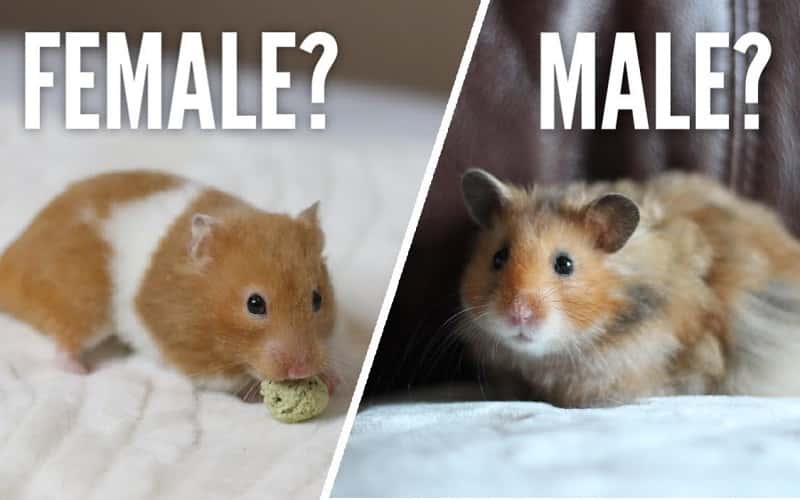If you're thinking about getting a hamster, you should know the differences between male and female hamsters.
This article will look at the physical characteristics, behavior patterns, reproductive differences, life expectancy, housing considerations, social interactions, size differences, care tips, feeding requirements, and suitability as pets of male and female hamsters.
Understanding Hamster Sexual Dimorphism
The physical differences between males and females of the same species are referred to as sexual dimorphism. There are noticeable differences in hamsters that can help determine their gender. As they mature, these distinctions become more apparent. It is critical to correctly identify a hamster's gender in order to provide proper care and avoid unintended breeding.
Physical differences between male and female hamsters
There are several physical differences between male and female hamsters. The location of their genital openings is one of the most noticeable differences. Males have a larger gap between the anus and the genital opening.
Female hamsters, on the other hand, have a smaller distance between these two openings, and their genital opening may appear as a small slit. Furthermore, male hamsters have testicles, whereas females do not.
Behavioral differences between Hamster sexes
Male and female hamster behavior can differ significantly. Male hamsters are more territorial and aggressive than females. They may use scent marking to assert dominance and protect their territory.
Female hamsters, on the other hand, are more sociable and cooperative. Unless they are threatened or stressed, they are less likely to exhibit aggressive behavior.
Male and Female Hamster Reproductive Variations
One of the most noticeable differences between male and female hamsters is their reproductive abilities. Female hamsters go through estrus cycles, which are times when they are fertile and can conceive. These cycles occur every four days on average.
Male hamsters, on the other hand, do not have reproductive cycles and are sexually active all year. Unless intentional breeding is desired, male and female hamsters must be separated.
Male and female hamsters have different life expectancies.
Male and female hamsters have slightly different life expectancies. Male hamsters, on average, have a shorter lifespan than females.
This disparity is primarily due to males' increased risk of health issues such as testicular tumors. Both male and female hamsters can live for two to three years or longer with proper care and a healthy environment.
Considerations for Housing
Certain considerations should be taken into account when housing male and female hamsters. Because male hamsters are more territorial, ample space is required to prevent aggression and stress. To avoid conflicts, male hamsters should be housed separately.
Female hamsters, on the other hand, are more sociable and can often be housed together if properly introduced.
Male and female hamster social interactions
Male and female hamsters have different patterns of social interaction. Male hamsters may be aggressive toward other males, particularly if they perceive them as a threat to their territory or potential mates.
Female hamsters, on the other hand, are more compatible and can form harmonious social groups when introduced early and given adequate space and resources.
Male and Female Hamster Size Differences
Male and female hamsters can have significant size differences. Male hamsters are typically larger and heavier than females. This size disparity is more noticeable in some hamster species, such as the Syrian hamster. It is important to note, however, that individual hamster sizes can vary within each gender.
Male vs. Female Hamster Care
While the basic care requirements for male and female hamsters are the same, there are a few things to remember. It is critical to provide ample space for male hamsters, ensure proper ventilation, and carefully monitor their behavior for signs of aggression.
Female hamsters may benefit from social interaction with other females, but be wary of any signs of conflict.
Male and Female Hamster Feeding Requirements
Male and female hamsters have similar nutritional requirements. High-quality hamster pellets are the primary food source in a well-balanced diet for both genders.
Fresh vegetables, fruits, and occasional treats should also be consumed in moderation. To prevent obesity and nutritional deficiencies, it is critical to provide clean water at all times and to regularly monitor their food intake.
Pairing of Male and Female Hamsters
Hamster breeding necessitates careful planning and responsible behavior. If you intend to breed hamsters, proper male-female pairing is critical. Introduce the male and female hamsters slowly and under controlled conditions.
Keep a close eye on their behavior to ensure compatibility and avoid aggression. For advice on optimal breeding practices and the care of pregnant hamsters and their offspring, consult a knowledgeable veterinarian or breeder.
Male and female hamsters are equally suitable as pets.
Male and female hamsters can both make wonderful pets, but their suitability may vary depending on personal preferences and specific circumstances. Male hamsters may be better suited to owners who prefer a more independent pet with less social interaction. Female hamsters, with their sociable nature, can be a good choice for those looking for a companionable hamster.
Finally, understanding the differences between male and female hamsters is critical for providing proper care and ensuring their well-being. Physical characteristics and behavioral patterns, as well as reproductive differences and housing considerations, all contribute to the distinct traits displayed by male and female hamsters.
By taking these differences into account, you can create a nurturing environment that meets their specific needs and ensures a fulfilling and enjoyable hamster ownership experience.
source https://hamstercaretipsblog.blogspot.com/2023/08/male-and-female-hamster-difference-12.html


إرسال تعليق